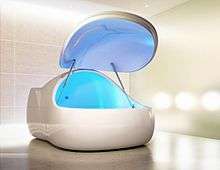Isolation tank

An isolation tank, originally called a sensory deprivation tank (a.k.a. float tank, flotation tank or sensory attenuation tank) is a lightless, soundproof tank with high epsom salt (magnesium sulphate) content filled with salt water at skin temperature, in which individuals float. They were first used by John C. Lilly[1] in 1954 to test the effects of sensory deprivation.
Float tanks were produced for commercial uses.[2] Flotation is widely advertised on the internet as a form of alternative medicine with claims that it has beneficial health effects, but these claims are not backed by good evidence.[3]
History
The isolation tank was developed in 1954 by John C. Lilly, a medical practitioner and neuropsychiatrist.[4][5][6] During his training in psychoanalysis at the US National Institute of Mental Health (NIMH), Lilly experimented with sensory deprivation. After 10 years of experimentation without taking any psychoactive substances, he tried floating in combination with a psychedelic agent, mostly LSD (at that time he was a researcher at NIMH, and LSD was legal in the US). He found that floating alone, without taking any substances, was a much better experience because of non-disturbed consciousness.[7]
Alternative medicine
Flotation has been widely advertised on the internet as a form of alternative medicine that has a number of health benefits, but the claims are often exaggerated and poorly-evidenced.[3] Despite the lack of scientific support, people have sought treatment from flotation for many conditions including muscle tension, chronic pain, hypertension, and rheumatoid arthritis to PMS.[8]
Notable users
The physicist Richard Feynman's experiences in a sensory deprivation tank were documented in the popular book Surely You're Joking, Mr. Feynman!. Feynman was invited to try the isolation tank at John Lilly's home after Lilly attended one of Feynman's popular lectures on quantum mechanics.
American Chef Anthony Bourdain was a regular user of flotation tanks in the 1980s after long shifts running a restaurant.[9]
Carl Lewis used in-tank visualization techniques to prepare himself for his gold medal long jump at the 1988 Seoul Olympics.[10]
John Lennon reportedly used a flotation tank in 1979 in an attempt to kick his heroin habit.[11]
See also
- Altered state of consciousness
- Altered States, a 1980 film based on Lilly's experiments
- Dark retreat
- Prisoner's cinema
- Psychedelic experience
- Sensory deprivation
References
- ↑ Lilly, John C. & E.J. Gold (2000). Tanks for the Memories: Flotation Tank Talks. Gateways Books & Tapes. ISBN 0-89556-071-2
- ↑ Efrati, Amir. "Float Centers Gaining Steam". The Wall Street Journal. Retrieved May 15, 2013.
- 1 2 Jonsson K, Kjellgren A (2014). "Curing the sick and creating supermen – How relaxation in flotation tanks is advertised on the Internet". European Journal of Integrative Medicine. 6 (5): 601–609. doi:10.1016/j.eujim.2014.05.005. ISSN 1876-3820.
- ↑ Black, David (December 10, 1979). "Lie down in darkness". New York Magazine. 12 (48): 60. ISSN 0028-7369.
- ↑ Gelb, Michael; Sarah Miller Caldicott (2007). Innovate Like Edison. Dutton. p. 140. ISBN 0-525-95031-1.
- ↑ Lilly, John Cunningham (1996). The Scientist: A Metaphysical Autobiography (3 ed.). Ronin Publishing. p. 102. ISBN 0-914171-72-0.
- ↑ Lilly, John C. (2002). The Deep Self: Consciousness Exploration in the Isolation Tank. pp. 59–60. ISBN 978-0895561169.
- ↑ "Why do people use flotation tanks?". BBC News Magazine. 2016-02-09. Retrieved 2016-09-23.
- ↑ "Bourdain in the Tank | FIGHTLAND". Retrieved 2016-09-23.
- ↑ "Floatation Tanks, Three Powerful Healing Therapies in One!". CNN iReport. Retrieved 2016-09-23.
- ↑ Times, Special To The New York (1981-11-21). "RELAXATION TANKS: A MARKET DEVELOPS". The New York Times. ISSN 0362-4331. Retrieved 2016-09-23.
| Wikimedia Commons has media related to Isolation tank. |